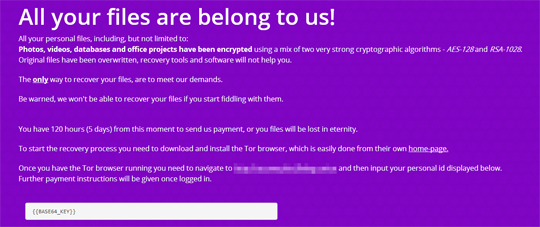RANSOM_RARANS.A
Gen:Variant.Ransom.RaRans.1 (F-Secure); Win32/Filecoder.NRB (ESET-NOD32)
Windows


Threat Type: Ransomware
Destructiveness: No
Encrypted: No
In the wild: Yes
OVERVIEW
Downloaded from the Internet
This Ransomware arrives on a system as a file dropped by other malware or as a file downloaded unknowingly by users when visiting malicious sites.
It encrypts files with specific file extensions. It drops files as ransom note.
TECHNICAL DETAILS
66,560 bytes
EXE
Yes
02 Jul 2018
Connects to URLs/IPs, Displays message/message boxes, Encrypts files
Arrival Details
This Ransomware arrives on a system as a file dropped by other malware or as a file downloaded unknowingly by users when visiting malicious sites.
Installation
This Ransomware adds the following folders:
- %Application Data%\XVNAW
(Note: %Application Data% is the Application Data folder, where it usually is C:\Documents and Settings\{user name}\Application Data on Windows 2000, Windows Server 2003, and Windows XP (32- and 64-bit); C:\Users\{user name}\AppData\Roaming on Windows Vista (32- and 64-bit), Windows 7 (32- and 64-bit), Windows 8 (32- and 64-bit), Windows 8.1 (32- and 64-bit), Windows Server 2008, and Windows Server 2012.)
It drops the following copies of itself into the affected system and executes them:
- %Application Data%\XVNAW\XVNAW.exe
(Note: %Application Data% is the Application Data folder, where it usually is C:\Documents and Settings\{user name}\Application Data on Windows 2000, Windows Server 2003, and Windows XP (32- and 64-bit); C:\Users\{user name}\AppData\Roaming on Windows Vista (32- and 64-bit), Windows 7 (32- and 64-bit), Windows 8 (32- and 64-bit), Windows 8.1 (32- and 64-bit), Windows Server 2008, and Windows Server 2012.)
It drops the following component file(s):
- %Application Data%\XVNAW\public.key
- %Application Data%\XVNAW\private.enc
(Note: %Application Data% is the Application Data folder, where it usually is C:\Documents and Settings\{user name}\Application Data on Windows 2000, Windows Server 2003, and Windows XP (32- and 64-bit); C:\Users\{user name}\AppData\Roaming on Windows Vista (32- and 64-bit), Windows 7 (32- and 64-bit), Windows 8 (32- and 64-bit), Windows 8.1 (32- and 64-bit), Windows Server 2008, and Windows Server 2012.)
Autostart Technique
This Ransomware adds the following registry entries to enable its automatic execution at every system startup:
HKEY_CURRENT_USER\Software\Microsoft\
Windows\CurrentVersion\Run
XVNAW = %Application Data%\XVNAW\XVNAW.exe
Other Details
This Ransomware does the following:
- Executes the following commands:
cmd.exe /C ping 1.1.1.1 -n 1 -w 3000 > Nul & Del "{malware path}"vssadmin.exe Delete Shadows /All /Quiet
- It connects to the following URL(s): http://bitly.com/{BLOCKED}E
Ransomware Routine
This Ransomware encrypts files with the following extensions:
- .asp
- .aspl
- .bat
- .bmp
- .bz2
- .class
- .djvu
- .DOC
- .docb
- .docm
- .docx
- .DOT
- .dotm
- .dotx
- .gif
- .java
- .jpeg
- .jpg
- .lay6
- .mpeg
- .ms11
- .out
- .pem
- .png
- .potm
- .potx
- .ppam
- .ppsm
- .ppsx
- .PPT
- .pptm
- .pptx
- .qcow2
- .RTF
- .sldm
- .sldx
- .SQLITE3
- .SQLITEDB
- .sqSTR
- .tar
- .tiff
- .txt
- .vbs
- .vmdk
- .wav
- .wmv
- .XLS
- .xlsb
- .xlsm
- .xlsx
- .xltm
- .xltx
- .xml
- .zip
It avoids encrypting files with the following strings in their file name:
- $Recycle.Bin
- thumbs.db
- wallet.dat
- winnt
It avoids encrypting files found in the following folders:
- AppData
- Application Data
- Program Files
- Program Files(x86)
- System Volume Information
- Windows
It renames encrypted files using the following names:
- Base64 equivalent of the filename.
It appends the following extension to the file name of the encrypted files:
- .XVNAW
It drops the following file(s) as ransom note:
- %Desktop%\RaRansomware - Recovery instructions.html

SOLUTION
9.850
14.370.04
10 Jul 2018
14.371.00
11 Jul 2018
Step 1
Before doing any scans, Windows XP, Windows Vista, and Windows 7 users must disable System Restore to allow full scanning of their computers.
Step 2
Note that not all files, folders, and registry keys and entries are installed on your computer during this malware's/spyware's/grayware's execution. This may be due to incomplete installation or other operating system conditions. If you do not find the same files/folders/registry information, please proceed to the next step.
Step 3
Restart in Safe Mode
Step 4
Delete this registry value
Important: Editing the Windows Registry incorrectly can lead to irreversible system malfunction. Please do this step only if you know how or you can ask assistance from your system administrator. Else, check this Microsoft article first before modifying your computer's registry.
- In HKEY_CURRENT_USER\Software\Microsoft\Windows\CurrentVersion\Run
- XVNAW = %Application Data%\XVNAW\XVNAW.exe
- XVNAW = %Application Data%\XVNAW\XVNAW.exe
Step 5
Search and delete these files
- %Application Data%\XVNAW
Step 6
Restart in normal mode and scan your computer with your Trend Micro product for files detected as RANSOM_RARANS.A. If the detected files have already been cleaned, deleted, or quarantined by your Trend Micro product, no further step is required. You may opt to simply delete the quarantined files. Please check this Knowledge Base page for more information.
Step 7
Restore encrypted files from backup.
Did this description help? Tell us how we did.

